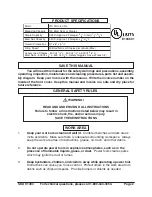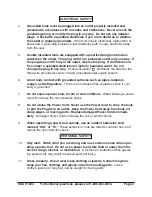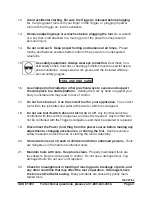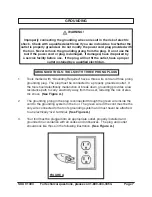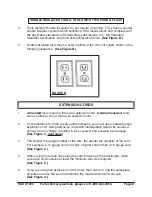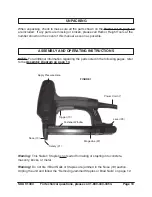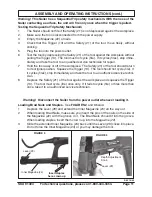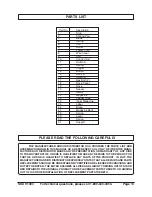
SKU 91494
Page 12
For technical questions, please call 1-800-444-3353.
OPERATING INSTRUCTIONS
When the unit is loaded with fasteners and you are ready to begin,
plug the Nailer / Stapler Power Cord (7) into a power outlet.
1.
Hold the tool with both hands, so that the Nose (19) is flat against
the workpiece, making sure that the Safety (21) is also firmly
against the workpiece.
2.
Gently squeeze the Trigger (13) to fire the tool.
3.
If you need a deeper driving depth, adjust the Depth Adjustment
Knob. See
FIGURE 3
on page 11 and
FIGURE 4
to the right.
Note:
Practice depth adjustment on scrap material first.
4.
If more depth is needed, and you are nailing or stapling into a
hard surface, you may apply pressure on the top of the unit. See
FIGURE 1
on page 10. On soft surfaces do not apply excessive
pressure or the Brad Nail or Staple may penetrate the workpiece
too deeply.
Note:
Each time you fire the Nailer / Staple Gun, the Safety (21) must
be pressed firmly against the workpiece.
Removing Jammed Staples or Brad Nails
1.
First, unplug the Nailer / Stapler.
If a nail is jammed in the discharge area, simply
remove it with pliers.
2.
If a nail is jammed in the Magazine (22), depress the Lever (29) and extend the
Inner Magazine (24) all the way out. See
FIGURES 2
and
3
. Use a flat screwdriver
and/or needle nose pliers to free the Brad Nail or Staple.
INSPECTION, MAINTENANCE, AND CLEANING
1.
WARNING!
Make sure that the tool is unplugged from its electrical outlet
before performing any inspection, maintenance, or cleaning procedures.
2.
BEFORE EACH USE,
inspect the general condition of the Nailer / Stapler.
Check for loose screws, misalignment or binding of moving parts, cracked or
broken parts, damaged electrical wiring, and any other condition that may affect
its safe operation. If abnormal noise or vibration occurs, have the problem cor-
rected before further use.
Do not use damaged equipment.
3.
Wipe tool clean with a lint free cloth and inspect it for damage. Do not use the
tool if you find damage. Have it repaired by an authorized service technician.
4.
Keep all screws tight. Loose screws may damage the tool and cause personal
injury.
5.
Make sure the Nose (19) is clear of all dirt or debris.
FIGURE 4


